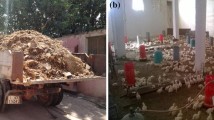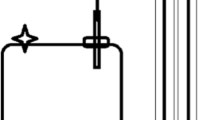Abstract
Feather is produced in large amounts as waste in poultry slaughterhouses. Only 60–70 % of the poultry slaughterhouse products are edible for human. The 15–20 % of the slaughterhouse by-products contains keratin; the proportion of feather is 7–9 %. The high protein content of chicken feather makes it an excellent raw material for biogas production. The keratin-content of feather can be difficulty digested, therefore physical, chemical and/or biological pre-treatment are required to the utilization. Our main objectives were to determine the effect of enzymatic pre-treatment, methane potential of chicken feather waste and the most effective treatment ratios. Student’s t test and Variance analysis with Tukey’s test were applied to examine significant differences between the control and different treatments. Chicken feather was enzymatic degraded, and then digested in anaerobic bioreactors in different ratios. Cattle slurry was used as control without feather. The bioreactor system (four digesters with 6 L volume) was controlled by ACE SCADA software running on Linux operating system which granted pre-programmed measurement and points of intervention for pH, temperature, CH4, CO2, O2. The content of the gas mixture was monitored with custom created gas-analyser and with MX42A gas-analyser (H2S, NH3) which was basis for absorbance measurement. Solubilisation degree (%)—calculated from sCOD—shows 66.23 % difference compared to the control experiments. The 5 % feather mixture ratio resulted in the highest methane yield, the maximal value was 0.37 ± 0.16 Nm3/kg VS. Due to the amount of produced hydrogen sulphide and ammonia (mg/kg) content the critical mixing ratio of feather proved to 5 % in laboratory scale.









Similar content being viewed by others
References
Kunert, J.: Keratin decomposition by dermatophytes: evidence of sulphitolysis of the protein. Experientia 33, 489–498 (1973)
Kaluzewska, M., Wawrzkiewicz, K., Lobarzewski, J.: Microscopic examination of keratin substrates subjected to the action of the enzymes of Streptomyces fradiae. Int. Biodeterior. 27, 11–26 (1991)
Friedrich, A.B., Antranikian, G.: Keratin degradation by Fervidobacterium pennavorans, a novel thermophilic anaerobic species of the order Thermotogales. Appl. Environ. Microbiol. 62, 2875–2882 (1996)
Hegedűs, M., Schmidt, J., Rafai P.: Állati eredetű melléktermékek hasznosítása (Animal by-product recycle). pp. 15–29, pp. 65–93. Mezőgazda Publischer, Budapest, Hungary (1998)
Perei, K., Bagi, Z., Bálint, B., Csanádi, Gy.,.Hofner, P., Horváth, L., Kardos, Gy., Magony, M., Rákhely, G., Román, Gy., Tóth, A., Zsíros, Sz., Kovács, L. K.: Mikrobák környezetvédelmi biotechnológiai hasznosításra. (Utilisation of microorganism by environmental biotechnology) In: Székács, A (ed.) Biokémia (Biochemistry). A Magyar Biokémiai Egyesület tájékoztatója. 28. 3. pp. 54–58 (2004)
Bíró, T., Mézes L., Petis, M., Kovács, L.K., Bagi, Z. Hunyadi, G.: A baromfi toll, mint biogáz alapanyag. (Chicken feather, as biogas raw material). In: Kiss, T., Somogyvári, M. (eds.) Via Futuri 2007. A biomassza alapú energiatermelés. Pécs. pp. 156–163. BIOKOM Kft. Pécs, Hungary (2008)
Steinert, P.M.: Structure, function, and dynamics of keratin intermediate filaments. J. Invest. Dermatol. 100, 729–734 (1993)
Wang, X., Parsons, C.M.: Effect of processing systems on protein quality of feather meal and hair meals. Poult. Sci. 76, 491–496 (1997)
Letourneau, F., Soussotte, V., Bressollier, P., Branland, P., Verneuil, B.: Keratinolytic activity of Streptomyces sp. S.K.1-02: a new isolated strain. Lett. Appl. Microbiol. 26, 77–80 (1998)
Onifade, A.A., Al-Sane, N.A., Al-Mussallam, A.A., Al-Zarbam, S.: A review: potentials for biotechnological applications of keratin-degrading microorganisms and their enzymes for nutritional improvement of feathers and other keratins as livestock feed resources. Biores. Technol. 66, 1–11 (1998)
Letourneau, F., Soussotte, V., Bressollier, P., Branland, P., Verneuil, B.: Keratinolytic activity of Streptomyces sp. S.K.1-02: a new isolated strain. Lett. Appl. Microbiol. 26, 77–80 (1998)
Kaul, S., Sumbali, G.: Keratinolysis by poultry farm soil fungi. Mycopathologia 139, 137–140 (1997)
Arvanitoyannis, I.S., Ladas, D.: Meat waste treatment methods and potential uses. Int. J. Food Sci. Technol. (2007). doi:10.1111/j.1365-2621.2006.01492.x
Kao, M.M., Lai, H.Y.: The study of the selection of feather-degrading microorganismus. J. Chin. Inst. Environ. Eng. 5, 37–43 (1995)
Williams, C.M., Richester, C.S., Mackenzi, J.M., Shih, J.C.H.: Isolation, identification and characterization of a feather-degrading bacterium. Appl. Environ. Microbiol. 56, 1509–1515 (1990)
Wang, J.J., Shih, J.C.H.: Fermentation production of keratinase from Bacillus licheniformis PWD-1 and a recombinant B. subtilis FDB-29. J. Ind. Microbiol. Biotechnol. 22(6), 608–616 (1999)
Lin, X., Delemen, D.W., Miller, E.S., Shih, J.C.: DNA nucleotide sequence of keratinase gene of Bacillus licheniformis. Appl. Environ. Microbiol. 61(4), 1469–1474 (1995)
Kovács, K.L., Bagi, Z., Perei, R.K., Csanádi, Gy., Fodor, B., Kovács, Á.T., Maróti, G., Magony, M., Bálint, B., Valastyán, P., Rákhely, G.: Biohydrogen, biogas, bioremediation. Proceedings of “Power of Microbes in Industry and Environment” Conference, Opatija, Croatia, 7–9 June, p. 17 (2002)
Bálint, B., Bagi, Z., Tóth, A., Rákhely, G., Perei, K., Kovács, K.L.: Utilization of keratin-containing biowaste to produce biohydrogen. Appl. Microbiol. Biotechnol. 69(4), 404–410 (2005)
Williams, C.M., Richester, C.S., Mackenzi, J.M., Shih, J.C.H.: Isolation, identification and characterization of a feather-degrading bacterium. Appl. Environ. Microbiol. 56, 1509–1515 (1990)
Shih, J.C.H.: Recent development in poultry waste digestion and feather utilization—a review. Poult. Sci. 72, 1617–1620 (1993)
Müller-Hellwig, S., Groschup, M.H., Pichner, R.: Biochemical evidence for the proteolytic degradation of infectious prion protein PrPsc in hamster brain homogenates by foodborne bacteria. Syst. Appl. Microbiol. 29(2), 165–171 (2006)
Mazotto, A.M., de Melo, A.C.N., Macrae, A.: Biodegradation of feather waste by extracellular keratinases and gelatinases from Bacillus spp. World J. Microbiol. Biotechnol. 27(6), 1355–1365 (2010)
Jørgensen, P.J. (ed.): Biogas-green energy. PlanEnergi and Researcher for a Day. Faculty of Agricultural Sciences, Aarhus University. Digisource Danmark A/S (2009)
Kadam, P.C., Boone, D.R.: Influence of pH ammonia accumulation and toxicity in halophilic, methylotrophic methanogens. Appl. Environ. Microbiol. 62(12), 4486–4492 (1996)
Angelidaki, I., Ahring, B.K.: Thermophilic anaerobic digestion of livestock waste: effect of ammonia. Appl. Microbiol. Biotechnol. 38, 560–564 (1993)
Krylova, N.I., Khabiboulline, R.E., Naumova, R.P., Nagel, M.A.: The influence of ammonium and methods for removal during the anaerobic treatment of poultry manure. J. Chem. Tech. Biotechnol. 70, 99–105 (1997)
Salminen, E., Rintala, J.: Anaerobic digestion of organic solid poultry slaughterhouse waste- a review. Bioresour. Technol. 83, 13–26 (2002)
Forgács G.: Biogas production from citrus wastes and chicken feather: pretreatment and co-digestion. Doctoral thesis. University of Borås. School of Engineering (2012)
Cuetos, M.J., Gómez, X., Otero, M., Morán, A.: Anaerobic digestion of solid slaughterhouse waste (SHW) at laboratory scale: influence of co-digestion with the organic fraction of municipal solid waste (OFMSW). Biochem Eng J (2008). doi:10.1016/j.bej.2007.11.019
Alvarez, R., Lidén, G.: Semi-continuous co-digestion of solid slaughterhouse waste, manure, and fruit and vegetable waste. Renew. Energy 33(4), 726–734 (2008). doi:10.1016/j.renene.2007.05.001
Cuetos, M.J., Gómez, X., Otero, M., Morán, A.: Anaerobic digestion and co-digestion of slaughterhouse waste (SHW): influence of heat and pressure pre-treatment in biogas yield. Waste Manag. 30(10), 1780–1789 (2010). doi:10.1016/j.wasman.2010.01.034
Salminen, E.A., Rintala, J.A.: Anaerobic digestion of poultry slaughtering wastes. Environ. Technol. 20, 21–28 (1999)
Salminen, E., Rintala, J., Lokshina, L.Y., Vavilin, V.A.: Anaerobic batch degradation of solid poultry slaughterhouse waste. Water Sci. Technol. 41(3), 33–41 (2000)
Xia, Y., Massé, D.I., McAllister, T.A., Beaulieu, C., Ungerfeld, E.: Anaerobic digestion of chicken feather with swine manure or slaughterhouse sludge for biogas production. Waste Manag. 32(3), 404–409 (2012)
APHA: Standard Methods for the Examination of Water and Waste Water, 20th edn. American Public Health Association, Washington, DC (1998)
Miller, J.H.: Experiments in Molecular Genetics. Cold Spring Harbor Laboratory, Cold Spring Harbor, New York (1972)
Bradford, M.M.: A rapid and sensitive method for the quantitation of microgram quantities of protein utilizing the principle of protein-dye binding. Anal. Biochem. 72, 248–254 (1976)
Forgács, G., Niklasson, C., Sárvári Horváth, I., Taherzadeh, M.J.: Methane production from feather waste pretreated with Ca(OH)2: process development and economical analysis. Waste Biomass Valor. 5(1), 65–73 (2013)
Mézes, L., Bíró, T, Tamás, J.: Results of biogas production experiments based on agricultural and food industry wastes. In: Tamás, J., Csép, N.I., Jávor, A (eds.) Natural resources and sustainable development. Acta Agraria Debreceniensis. Supplement. 297–303 (2008)
Tamás, J., Mézes, L., Biró, Gy., Nyírcsák, M., Borbély, J.: Fuzzy system to optimize the anaerobic digestion in biogas reactors. Orbit 2012. Proceedings of the 8th International Conference on Global assessment for organic resources and waste management. Rennes, France, 12–15 June, CD. pp. 35–39 (2012)
Mézes, L., Tamás, J.: Biogas controlling system testing with poultry feather recycling. Hung. Agric. Res. 23(3), 5–9 (2014)
Papadopoulos, M.C.: Processed chicken feathers as feedstuff for poultry and swine. A review. Agric. Wastes 14, 275–290 (1985)
Schofield, R., Thomas, D.S.G., Kirkby, M.J.: Causal processes of soil salinization in Tunisia, Spain and Hungary. Land Degrad. Dev. 12(2), 163–181 (2001)
Szabolcs, I.: European solonetz soils and their reclamation. Akadémiai Kiadó, Budapest (1971)
Hungarian Central Statistical Office (KSH). Statistical data (1986)
Várallyai Gy., Fejér E.: Adatok az öntözővizek minőségi megítéléséhez. Kisérl. Közl. 39, 1–3 (1936)
Ayers, R.S., Westcot, D.W.: Water Quality for Agriculture. FAO Irrigation and Drainage Paper 29, Rev. 1. Rome. p. 174 (1985)
Mézes, L., Nagy, A., Gálya, B., Tamás, J.: Poultry feather wastes recycling possibility as soil nutrient. Proceedings Book. 9th International Soil Science Congress on “The Soul of Soil and Civilization (EURASIAN SOIL 2014)”, Side, Antalya, Turkey, 14–17 Oct (2014) (in process)
Forgács, G., Alinezhad, S., Mirabdollah, A., Feuk-Lagerstedt, E., Sárvári Horváth, I.: Biological treatment of chicken feather waste for improved biogas production. J. Environ. Sci. 23(10), 1747–1753 (2011)
Acknowledgments
We thank to Prof. Kornél L. Kovács, Dr. Zoltán Bagi (University of Szeged, Department of Biotechnology), Szabolcs Molnár, Richárd Kun (University of Debrecen) for professional support and for assistance in the research. We thank to Bence Mátyás and Nikoletta Szalóki for helpful English grammatical advice. This research was supported by the European Union and the State of Hungary, co-financed by the European Social Fund in the framework of TÁMOP-4.2.4.A/2-11/1-2012-0001 ‘National Excellence Program’.
Author information
Authors and Affiliations
Corresponding author
Rights and permissions
About this article
Cite this article
Mézes, L., Tamás, J. Feather Waste Recycling for Biogas Production. Waste Biomass Valor 6, 899–911 (2015). https://doi.org/10.1007/s12649-015-9427-7
Received:
Accepted:
Published:
Issue Date:
DOI: https://doi.org/10.1007/s12649-015-9427-7




